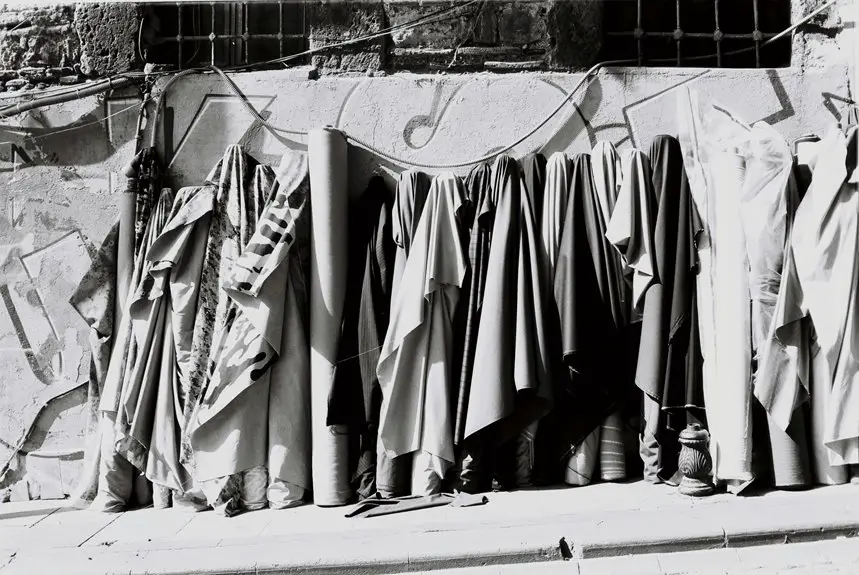Silk Crepe De Chine is a lightweight, luxurious fabric known for its slightly pebbled texture and graceful drape. You’ll find it smooth yet crisp, with a matte finish that adds subtle elegance. Originating from ancient Chinese silk traditions, this fabric is prized for blouses, dresses, and evening wear. It needs gentle care like hand washing and careful storage to maintain its beauty. Keep exploring to uncover how to choose and care for this timeless textile perfectly.
Table of Contents
Key Takeaways
- Silk Crepe De Chine is a lightweight silk fabric with a subtle pebbled texture and matte finish, prized for its delicate drape and elegance.
- Originating from ancient Chinese weaving, it reflects a unique crinkled surface created by tightly twisted yarns.
- It is commonly used in blouses, dresses, scarves, and evening wear due to its luxurious feel and excellent dye retention.
- Care involves gentle hand washing in cold water, flat drying away from sunlight, and storing in cool, dry conditions.
- High-quality Silk Crepe De Chine is 100% mulberry silk with a consistent, tight weave and a smooth yet slightly grainy texture.
The History and Origin of Silk Crepe De Chine
Although its exact beginnings are debated, Silk Crepe De Chine has long been prized for its unique texture and delicate drape. You’ll find that this fabric originated from the weaving traditions of China, where silk production has thrived for thousands of years.
Silk Crepe De Chine, cherished for its texture and drape, traces back to ancient Chinese silk weaving traditions.
Over time, silk weaving techniques spread to Europe, especially France, where the term “Crepe De Chine” was coined, referring to the crepe-like crinkled surface.
When you choose Silk Crepe De Chine, you’re embracing a fabric with a rich heritage that blends Eastern silk craftsmanship with Western innovation. This fusion makes it a timeless choice for elegant garments.
As you explore its history, you’ll appreciate how this fabric’s journey reflects cultural exchanges and evolving textile technology.
Characteristics and Texture of Silk Crepe De Chine
Silk Crepe De Chine stands out for its subtle pebbled texture and lightweight feel, making it a favorite among designers and wearers alike.
When you touch it, you’ll notice a slightly grainy surface that adds depth without roughness. Its softness drapes beautifully, offering a graceful flow that flatters any silhouette. Plus, it has a matte finish that gives it an understated elegance.
Here’s what to expect from its characteristics and texture:
- Fine, tightly twisted yarns create a crisp yet soft fabric
- Slightly crinkled surface provides a unique tactile experience
- Lightweight and breathable, ideal for comfort in various climates
This combination makes Silk Crepe De Chine both luxurious and practical for your wardrobe.
Common Uses and Applications in Fashion
When you choose Crepe De Chine fabric, you tap into a versatile material that designers love for its elegance and practicality.
You’ll find it commonly used in blouses, dresses, and scarves because its lightweight drape and subtle texture add sophistication without bulk. It’s perfect for tailored pieces like shirts and skirts, offering both comfort and a polished look.
Evening wear often incorporates this fabric due to its luxurious feel and graceful movement. Additionally, Crepe De Chine works well in layering pieces, allowing you to create stylish, breathable outfits.
Crepe De Chine’s luxurious feel and graceful movement make it ideal for elegant evening wear and breathable layering pieces.
Whether you’re aiming for casual chic or formal elegance, this fabric adapts seamlessly, making it a favorite choice in fashion collections worldwide.
Its ability to hold dye beautifully also guarantees vibrant, lasting colors in your wardrobe.
How to Care for and Maintain Silk Crepe De Chine
To keep your Crepe De Chine garments looking their best and lasting longer, proper care plays a big role.
Start by handling the fabric gently—avoid wringing or twisting, as this can damage the delicate fibers. Always opt for hand washing in cold water with a mild detergent designed for silk. If you use a washing machine, place the item in a mesh bag on a delicate cycle.
After washing, lay your garment flat on a towel to dry, avoiding direct sunlight which can fade the color.
Here are three key tips to maintain your silk Crepe De Chine:
- Store in a cool, dry place away from direct light
- Use padded hangers to prevent distortion
- Avoid contact with harsh chemicals or perfumes that can weaken the fabric
Tips for Buying High-Quality Silk Crepe De Chine
If you’re looking to invest in silk Crepe De Chine, knowing how to spot quality makes all the difference.
First, check the fabric’s texture; it should feel smooth yet slightly pebbled, not rough or stiff.
Examine the weave closely—high-quality silk Crepe De Chine has a tight, consistent weave without gaps.
Look for a subtle matte finish with a gentle sheen, indicating authentic silk.
Pay attention to the weight; it should be lightweight but substantial enough to drape well.
Always verify the silk content—100% mulberry silk is ideal.
Finally, buy from reputable sellers who provide clear fabric details and offer samples if possible.
Frequently Asked Questions
Is Silk Crepe De Chine Fabric Hypoallergenic?
You’ll find silk crepe de chine fabric is generally hypoallergenic, so it’s great if you have sensitive skin. Its natural fibers resist dust mites and allergens, helping you stay comfortable without irritation.
Can Silk Crepe De Chine Be Blended With Other Fabrics?
Think of silk crepe de chine as a graceful dancer, effortlessly blending with others on stage. You can mix it with fabrics like cotton or polyester, creating garments that balance elegance with durability and comfort, perfectly suited for you.
How Does Silk Crepe De Chine Compare to Silk Chiffon?
You’ll find silk crepe de chine has a slightly heavier, textured feel compared to the sheer, lightweight silk chiffon. Crepe de chine drapes well and’s more opaque, making it ideal for structured garments versus chiffon’s flowy elegance.
What Is the Environmental Impact of Producing Silk Crepe De Chine?
You’ll find producing silk crepe de chine uses a lot of water and energy, impacting the environment. However, it’s biodegradable and renewable, so choosing responsibly sourced silk can help reduce its ecological footprint considerably.
Can Silk Crepe De Chine Fabric Be Dyed at Home?
You can dye silk crepe de chine at home, but you’ll need gentle silk-specific dyes and mild detergent. Always test a small swatch first to avoid damage, and follow dye instructions carefully for best results.
- Does Chiffon Fabric Stink - July 15, 2025
- Does Chiffon Fabric Affect the Economy - July 15, 2025
- Does Cotton Fabric Have a Nap - July 15, 2025







